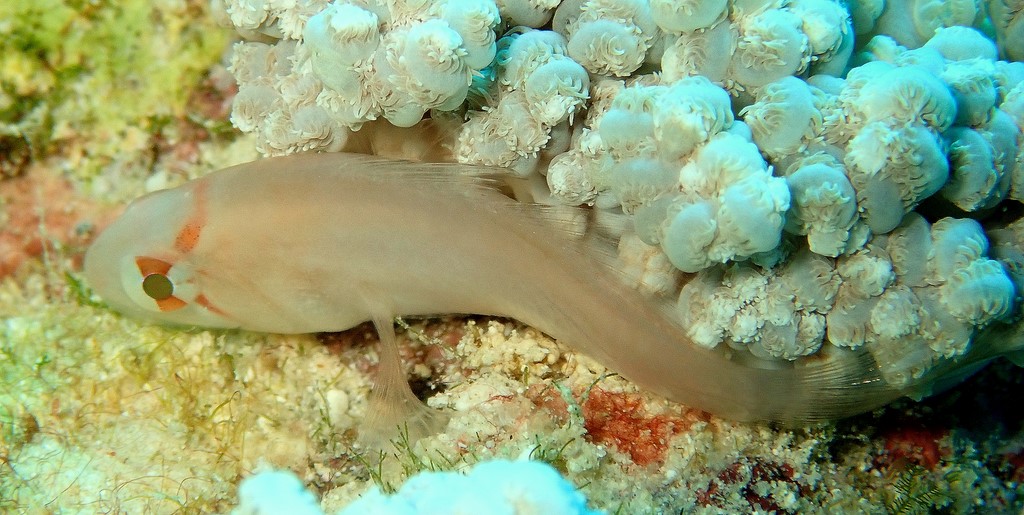NEAMIA OCTOSPINA - (SMITH & RADCLIFFE, 1912)
Picture courtesy of: Alain Daoulas
Actinopterygii (Gigaclass) > Actinopteri (Class) > Teleostei (Subclass) > Gobiiformes (Order) > Apogonoidei (Suborder) > Apogonidae (Family) > Apogoninae (Subfamily) > Neamia (Genus)
Poisson-cardinal à huit épines, Eightspine cardinalfish, Eight-spined cardinalfish, Agstekel-kardinaal, Yatsutoge-tenjikudai, ヤツトゲテンジクダイ, 八棘扁天竺鯛, 菲律賓八棘天竺鯛,
Synonymes
Apogonichthys coggeri (Whitley, 1964)
Neamia sphenurus (Klunzinger, 1884)
--------------------------
Description
Dorsal spines (total): 8 + 1, the last (8th) spine of the 1st dorsal fin joined to the second dorsal fin by a membrane; Dorsal soft rays (total): 9; Anal spines: 2; Anal soft rays: 8; Pectoral fin rays: 17-21 (usually: 18); Lateral line scales: 24; Gill rakers: 2 + 10-12 (developed rakers: 6-7). Prédorsal scales: 5-6. No palatines teeth; Caudal fin rounded. Max. length: 7.0 cm TL. Depth range: 3 - 5 m.
Color
Body uniformly pinkish-yellow; Dark radial cheek bars present around the lower part of the eyes.
Etymology
Neamia: from Latin, neos = new, young (used to form clade or taxonomic names indicating more recent branching than a morphologically or otherwise similar group) + from Greek, amia, -as = a kind of bonito. Name given by Aristotle to a fish (Later name applied to Apogon by Gronow (1763), now a commonly used suffix in the family).
octospina: from Latin, octo = numeral eight + from Latin, spīna = thorn-bush, black-thorn, sloe-tree. Referring to eight first-dorsal fin spines, compared to seven on Fowleria.
Original description: Neamia octospina Smith & Radcliffe, 1912 - Type locality: Rasa Island, Mantaguin Bay, Palawan (Southeast of Panakan, Narra Municipality, Palawan, Philippines, Sulu Sea, western Pacific).
Distribution
Red Sea; Indo-West Pacific: East Africa (Tanzania, Mozambique), Seychelles, Aldabra (Seychelles), Saint Brandon's Shoals (Cargados Carajos) and Chagos Archipelago east to New Guinea, north to Yaeyama Islands (Japan), south to northern Australia and New Caledonia.
Biology
Occurs inshore, near reefs. Secretive among boulders or under debris. Nocturnal species. Solitary. Distinct pairing during courtship and spawning. Mouth brooder.
Actinopterygii (Gigaclass) > Actinopteri (Class) > Teleostei (Subclass) > Gobiiformes (Order) > Apogonoidei (Suborder) > Apogonidae (Family) > Apogoninae (Subfamily) > Neamia (Genus)
Poisson-cardinal à huit épines, Eightspine cardinalfish, Eight-spined cardinalfish, Agstekel-kardinaal, Yatsutoge-tenjikudai, ヤツトゲテンジクダイ, 八棘扁天竺鯛, 菲律賓八棘天竺鯛,
Synonymes
Apogonichthys coggeri (Whitley, 1964)
Neamia sphenurus (Klunzinger, 1884)
--------------------------
Description
Dorsal spines (total): 8 + 1, the last (8th) spine of the 1st dorsal fin joined to the second dorsal fin by a membrane; Dorsal soft rays (total): 9; Anal spines: 2; Anal soft rays: 8; Pectoral fin rays: 17-21 (usually: 18); Lateral line scales: 24; Gill rakers: 2 + 10-12 (developed rakers: 6-7). Prédorsal scales: 5-6. No palatines teeth; Caudal fin rounded. Max. length: 7.0 cm TL. Depth range: 3 - 5 m.
Color
Body uniformly pinkish-yellow; Dark radial cheek bars present around the lower part of the eyes.
Etymology
Neamia: from Latin, neos = new, young (used to form clade or taxonomic names indicating more recent branching than a morphologically or otherwise similar group) + from Greek, amia, -as = a kind of bonito. Name given by Aristotle to a fish (Later name applied to Apogon by Gronow (1763), now a commonly used suffix in the family).
octospina: from Latin, octo = numeral eight + from Latin, spīna = thorn-bush, black-thorn, sloe-tree. Referring to eight first-dorsal fin spines, compared to seven on Fowleria.
Original description: Neamia octospina Smith & Radcliffe, 1912 - Type locality: Rasa Island, Mantaguin Bay, Palawan (Southeast of Panakan, Narra Municipality, Palawan, Philippines, Sulu Sea, western Pacific).
Distribution
Red Sea; Indo-West Pacific: East Africa (Tanzania, Mozambique), Seychelles, Aldabra (Seychelles), Saint Brandon's Shoals (Cargados Carajos) and Chagos Archipelago east to New Guinea, north to Yaeyama Islands (Japan), south to northern Australia and New Caledonia.
Biology
Occurs inshore, near reefs. Secretive among boulders or under debris. Nocturnal species. Solitary. Distinct pairing during courtship and spawning. Mouth brooder.
Last update: 5, November 2022
